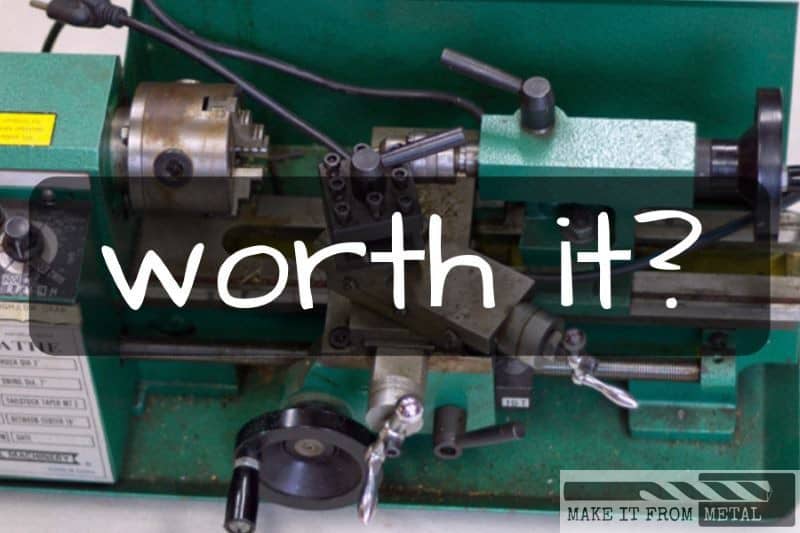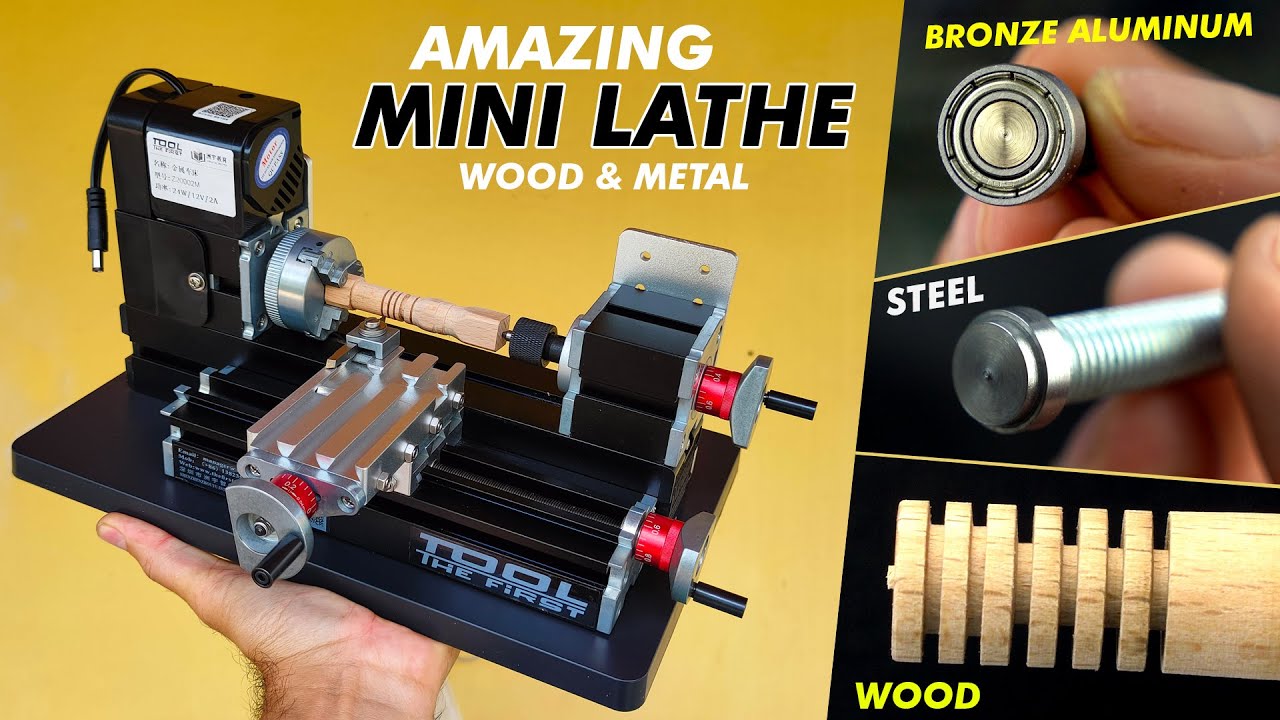If you’ve ever wondered “what can a mini lathe do?” you’re in the right place! Whether you’re a budding woodworker or a curious kid with an interest in DIY projects, a mini lathe can open up a whole new world of possibilities. From turning small wooden bowls and pens to crafting intricate spindles and knobs, a mini lathe is a versatile tool that lets you unleash your creativity.
With a mini lathe, you can take a plain block of wood and transform it into a beautifully shaped object. Imagine the satisfaction of turning a simple piece of timber into a custom-made chess piece or a decorative table leg. The possibilities are endless, and the only limit is your imagination!
Not only can a mini lathe create stunning wooden creations, but it can also be used with non-wood materials like plastic and soft metals. Whether you’re making small jewelry pieces or delicate metal fittings, a mini lathe allows you to shape and refine your materials with precision and finesse. So, if you’re looking for a tool that combines craftsmanship and creativity, a mini lathe might be just what you need! So let’s dive in and discover the incredible things you can do with a mini lathe.

What Can a Mini Lathe Do? Exploring the Versatility of a Small Powerhouse
Mini lathes are compact machines that can perform a wide range of tasks, making them an invaluable tool in the workshop. Despite their small size, these powerhouses pack a punch and are capable of transforming raw materials into intricate and precise pieces. From turning and facing to threading and grooving, a mini lathe offers a multitude of functions that cater to hobbyists, DIY enthusiasts, and professionals alike. In this article, we will delve into the world of mini lathes, exploring their capabilities, benefits, and tips for getting the most out of these incredible machines.
Making Precision Cuts and Shapes
One of the primary functions of a mini lathe is turning, which involves removing material from a spinning workpiece to create cylindrical shapes. This can be done by securing the workpiece in the lathe’s chuck and using various cutting tools to shape it. Mini lathes have adjustable speeds, allowing for precise control over the cutting process. Additionally, these machines often feature a bed and carriage system that facilitates smooth movements along both the X and Z axes. With the right techniques and tools, a mini lathe can turn everything from wooden pens and bowls to metal spindles and tool handles.
In addition to turning, mini lathes excel at facing operations. “Facing” refers to the process of creating a flat surface on the end of the workpiece. Whether you’re squaring the end of a wooden dowel or creating a smooth and flat surface on a metal rod, a mini lathe can accomplish this with ease. By properly aligning the cutting tool and making gradual cuts, you can achieve a precise and high-quality finish.
Creating Threads and Grooves
Another impressive capability of a mini lathe is its ability to create threads and grooves on a workpiece. This is accomplished using a combination of specialized cutting tools and the lathe’s lead screw. With the correct tooling and careful calculations, you can cut internal or external threads of various sizes and pitch. This makes mini lathes an essential tool for those working on projects that require threaded components, such as bolts, nuts, or custom fittings.
Grooving, on the other hand, involves using a cutting tool to create narrow channels or grooves on the surface of the workpiece. This technique is commonly employed when creating flutes on a turning project or when making precise cuts to accommodate O-rings or other mechanical elements. Mini lathes offer adjustable grooving tools, allowing for the precise control of groove depth and width, making them indispensable for those working on intricate designs and functional parts.
Benefits of Using a Mini Lathe
Mini lathes have gained popularity for several reasons. Their compact size makes them ideal for small workshops or hobbyists working in limited spaces. Additionally, these machines are often more affordable compared to their larger counterparts, making them accessible to a wider range of users. Despite their smaller size, mini lathes still offer impressive power and precision, allowing users to create intricate and professional-quality projects.
One of the significant advantages of mini lathes is their versatility. These machines can work with a variety of materials, including wood, plastic, and metal. They can handle projects ranging from simple pens and candlesticks to complex architectural details and intricate jewelry. This versatility makes mini lathes suitable for artists, craftsmen, and model makers who require a versatile machine that can accommodate different materials and project types.
Another benefit is the ease of use. Mini lathes are designed with user-friendly features that make them approachable for beginners. They often come with clear instruction manuals and intuitive controls, allowing users to quickly grasp the basics of lathe operation. This means that even if you’re new to turning or machining, you can start creating impressive pieces with minimal learning curve.
Tips for Getting the Most Out of Your Mini Lathe
To maximize the potential of your mini lathe, consider the following tips:
1. Invest in quality tools: Having sharp and properly sized cutting tools is essential for achieving precise and clean cuts. Invest in high-quality tools specifically designed for your mini lathe to ensure optimal performance.
2. Practice proper tool positioning: Achieving accurate cuts requires correct tool positioning. Take the time to learn about the correct angles and positions for different cutting operations, and practice proper tool techniques.
3. Patience is key: Precision work takes time and patience. Take your time when working on projects, and avoid rushing the process. Remember, slow and steady movements yield better results.
4. Experiment with different materials: Don’t limit yourself to a single material. Explore the capabilities of your mini lathe by working with different materials, such as wood, plastic, or metal. Each material offers unique challenges and possibilities.
5. Seek guidance from experienced turners: There is a wealth of knowledge and expertise within the turning community. Connect with experienced turners through forums, clubs, or online communities to learn from their experiences and gain valuable insights.
6. Regular maintenance and cleaning: Like any machine, regular maintenance and cleaning are crucial for optimal performance and longevity. Follow the manufacturer’s guidelines for maintenance, and keep your mini lathe clean and well-lubricated.
By harnessing the capabilities of a mini lathe, you can unlock endless creative possibilities and create beautiful and functional pieces. Whether you’re a woodworking enthusiast, a metalworker, or simply someone looking to delve into the world of turning, a mini lathe is a versatile tool that will undoubtedly enhance your craft. So, roll up your sleeves, unleash your creativity, and let your mini lathe bring your visions to life.
Key Takeaways: What Can a Mini Lathe Do?
- A mini lathe is a versatile tool that can be used for various woodworking projects.
- It allows you to turn cylindrical objects like pens, table legs, and bowls.
- With a mini lathe, you can create intricate designs and patterns on wood.
- You can also use it to make custom wooden knobs and handles for furniture.
- A mini lathe is ideal for hobbyists and beginners who want to explore woodworking.
Frequently Asked Questions
A mini lathe is a versatile tool that can be used for a variety of projects. Here are some commonly asked questions about what a mini lathe can do:
1. What are the main uses of a mini lathe?
A mini lathe is commonly used for turning wood or metal. It can create cylindrical shapes, bowls, spindles, and other custom pieces. Woodworkers and metalworkers often rely on mini lathes for precision and accuracy in their projects. Additionally, a mini lathe can be used for thread cutting, making it a valuable tool for creating screws, bolts, and other threaded components.
With the right attachments and accessories, a mini lathe can also be used for tasks such as sanding, polishing, drilling, and even milling. It offers the flexibility to tackle various projects, making it a great addition to any workshop.
2. Can a mini lathe be used by beginners?
Yes, a mini lathe can be used by beginners. While it may seem intimidating at first, with proper guidance and practice, beginners can quickly learn how to operate a mini lathe. Many manufacturers offer user-friendly models with intuitive controls, making it easier for newcomers to get started.
It’s important for beginners to start with smaller, simpler projects to familiarize themselves with the lathe’s operations and techniques. They should also adhere to safety guidelines and use appropriate safety equipment while working with a mini lathe.
3. What materials can be worked on with a mini lathe?
A mini lathe can work with a variety of materials, including wood, metal, and even certain plastics. When it comes to wood, common options include hardwoods such as maple, walnut, and oak, as well as softwoods like pine and cedar. For metalworking, a mini lathe can handle materials such as aluminum, brass, and steel.
It’s important to note that different materials may require specific cutting tools and techniques. It’s recommended to consult the lathe’s manual or seek guidance from experienced users or online resources to ensure the appropriate methods are used for each material.
4. Can a mini lathe be used for small-scale production?
Yes, a mini lathe can be used for small-scale production. While mini lathes are typically used for hobbyist or personal projects, they can still produce multiple identical pieces if needed. The key is to develop efficient workflows, such as using jigs and fixtures, and to optimize tooling setups for consistent results.
However, it’s worth noting that mini lathes may not be as efficient as larger industrial lathes for large-scale production. If high volume and speed are a priority, it might be more suitable to invest in a larger lathe designed for commercial purposes.
5. Are there any limitations to what a mini lathe can do?
While a mini lathe is a versatile tool, it does have some limitations. One of the main limitations is its size and power. Mini lathes are smaller and less powerful compared to their larger counterparts, which means they may not be able to handle extremely large or heavy workpieces.
Additionally, the maximum diameter and length of the workpiece that can be turned on a mini lathe are limited by the lathe’s specifications. It’s essential to choose a mini lathe that suits the size of the projects you plan to work on. If larger or longer workpieces are required, a larger lathe may be necessary.

Summary
A mini lathe is a handy tool that can be used to create various projects. It is small in size but mighty in functionality. With a mini lathe, you can turn wood or metal into beautiful and useful objects such as bowls, pens, and even custom parts for your projects. It allows you to shape and carve materials with precision and creativity. So, if you’re interested in woodworking or metalworking, a mini lathe can be a great tool to have in your workshop.
Not only does a mini lathe give you the ability to work on different materials and create unique items, but it also offers a great learning opportunity. By using a mini lathe, you can develop your skills in craftsmanship and design, while also exploring your creativity. Whether you’re a beginner or an experienced maker, a mini lathe can be a valuable addition to your toolkit. So, if you’re interested in crafting and making things with your own hands, give a mini lathe a try and unleash your creativity.
